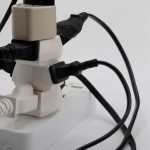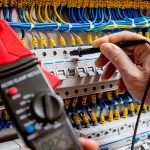Last Updated on 1 year by Francis
Electromotive force (EMF) and potential difference (PD) are two concepts in electricity that are often confused with each other. Although they are related, they are not the same thing. In this discussion, we will explore the difference between EMF and PD, and how they are related.
Contents
Understanding the Basics of EMF and Potential Difference
What is EMF?
EMF stands for Electromotive Force, which is the electrical potential difference between two points. It is the driving force that pushes electrons through a circuit. EMF is measured in volts and is usually represented by the letter “E.”
What is Potential Difference?
Potential difference, also known as voltage, is the difference in electric potential between two points in an electric circuit. It is measured in volts and is usually represented by the letter “V.”
Are EMF and Potential Difference the Same?
While EMF and potential difference may seem similar, they are not the same thing. EMF is the total amount of energy that a source can provide to an electric circuit, while potential difference is the difference in potential energy between two points in a circuit. In simpler terms, EMF is the force that drives electrons, while potential difference is the difference in energy between two points.
The Relationship between EMF and Potential Difference
One key takeaway from this text is that EMF and potential difference are related but not the same thing. EMF is the total energy that a source can provide to a circuit, while potential difference is the difference in energy between two points in a circuit. Understanding these concepts is crucial for ensuring that circuits function correctly and for preventing electrical hazards. It is also important to understand common misconceptions about EMF and potential difference, such as the idea that EMF is the same as current, resistance, power, or electromagnetic radiation.
How are EMF and Potential Difference Related?
EMF and potential difference are related in that EMF is the total amount of energy that a source can provide to an electric circuit, while potential difference is the difference in potential energy between two points in a circuit. In other words, EMF is the driving force behind the flow of electrons, while potential difference is the energy difference between two points in a circuit.
Can Potential Difference be Greater than EMF?
No, potential difference cannot be greater than EMF. The energy provided by the source (EMF) is the maximum amount of energy that can be transferred to the circuit. The potential difference between two points in the circuit cannot exceed the energy provided by the source.
The Importance of Understanding EMF and Potential Difference
Key takeaway: EMF and potential difference are not the same thing. EMF is the total amount of energy that a source can provide to an electric circuit, while potential difference is the difference in potential energy between two points in a circuit. Understanding these concepts is crucial for ensuring that circuits function correctly and efficiently and can help prevent electrical hazards.
Why is it Important to Understand EMF and Potential Difference?
Understanding EMF and potential difference is crucial for anyone working with electrical circuits. It helps to ensure that circuits function correctly and efficiently. Understanding EMF and potential difference can also help identify potential problems in a circuit and prevent electrical hazards.
What are the Risks of Not Understanding EMF and Potential Difference?
Not understanding EMF and potential difference can lead to a range of problems, including circuit failure, electrical hazards, and inefficient use of energy. In extreme cases, it can even lead to electrical fires and other safety hazards.
Common Misconceptions about EMF and Potential Difference
Is EMF the Same as Current?
No, EMF is not the same as current. EMF is the driving force behind the flow of electrons in a circuit, while current is the actual flow of electrons.
Is Potential Difference the Same as Resistance?
No, potential difference is not the same as resistance. Resistance is the measure of how much a material opposes the flow of electrons, while potential difference is the difference in potential energy between two points in a circuit.
Is EMF the Same as Power?
No, EMF is not the same as power. EMF is the driving force behind the flow of electrons in a circuit, while power is the rate at which energy is transferred in a circuit.
Is EMF the Same as Electromagnetic Radiation?
No, EMF is not the same as electromagnetic radiation. Electromagnetic radiation is a type of energy that travels through space, while EMF is the energy difference between two points in a circuit.
FAQs – Is EMF and Potential Difference the Same?
EMF stands for electromotive force. It is basically the electrical potential difference created between two points in a circuit that causes current to flow.
Potential difference is the difference in electrical potential energy between two points in a circuit. It can be described as the amount of work required to move a unit charge from one point to another.
Is EMF and Potential Difference the Same Thing?
No, EMF and potential difference are not the same thing. While both are measurements of the energy difference between two points in a circuit, EMF refers to the total energy difference while potential difference refers to the difference per unit charge.
What is the Difference Between EMF and Potential Difference?
The key difference between EMF and potential difference is that EMF refers to the total energy difference between two points in a circuit, while potential difference refers to the energy difference per unit charge. Another way to think about it is that EMF is the driving force behind the flow of current in a circuit, while potential difference is the resistance that must be overcome to allow the current to flow.
Can Potential Difference and EMF Be Measured?
Yes, both potential difference and EMF can be measured. Potential difference can be measured using a voltmeter, which measures the difference in electrical potential energy between two points in a circuit. EMF can be measured using various methods, including by using a galvanometer and a potentiometer.
Are There Any Practical Applications of Knowing the Difference Between EMF and Potential Difference?
Yes, understanding the difference between EMF and potential difference is important in various fields, including electrical engineering, physics, and chemistry. It can help scientists and engineers design and optimize electrical systems, such as batteries, generators, and motors, by ensuring that they work efficiently and effectively to provide a reliable power source.




.jpg)



